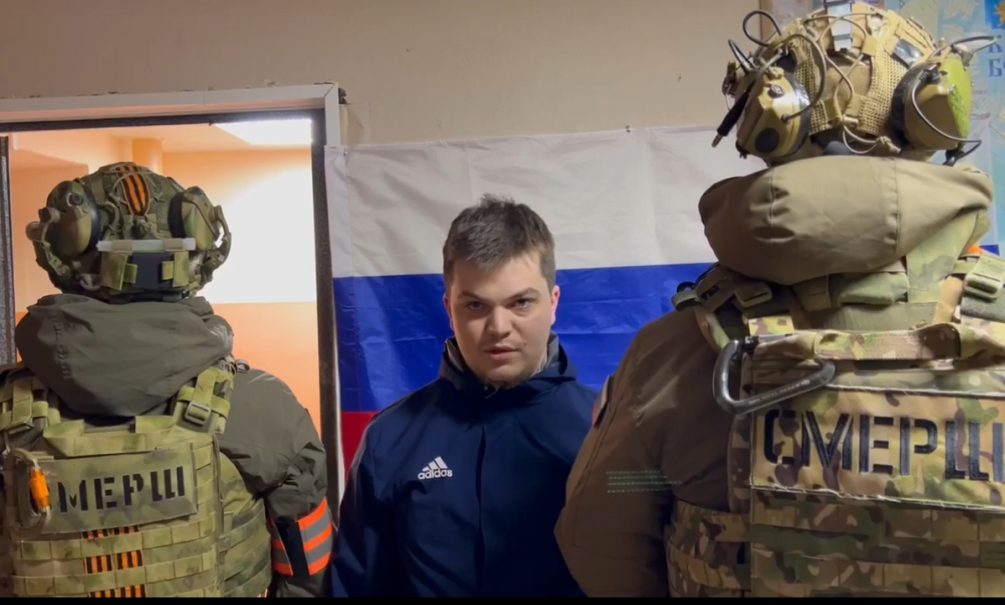On April 14th 1943, following Nazy Germany’s failed invasion of the USSR, Joseph Stalin ordered the creation of three separate Army or Naval counterintelligence agencies. Their mission was to eliminate all Nazi spies infiltrating the Soviet Union, along with any Soviet citizens suspected of defecting to Germany.
- At the top of this hierarchy within these three agencies was the GUKR-NKO, the State Directive of Counterintelligence.
- Second in the ranks was a section of the Navy Commissariat 3rd Directorate, or Red Fleet, this section became known as the UKR, Directorate of Counterintelligence.
- Finally, there was a division of NKVD, the People’s Commissariat for Internal Affairs. This department was known as the OKR, the Department of Counterintelligence.
Together these three agencies operated under the umbrella of SMERSH. They were also referred to as GUKR-SMERSH, UKR-SMERSH and OKR-SMERSH respectively.1 SMERSH was a portmanteau of a phrase first coined by Stalin himself, “Smertʹ shpionam!” which is Russian for “Death to spies!”

It was SMERSH who found Adolf Hitler’s body after he committed suicide. After the war, SMERSH was shutdown and its duties transferred to the Ministry of States Security (MGB) on May 4 1946. But that didn’t stop fiction authors from expanding its existence in their stories.
Ian Fleming of course was the first to start this trend. In 1953, he published his first novel, Casino Royale, which pitched his fictional superspy James Bond against SMERSH paymaster Le Chiffre. For much of the rest of Fleming’s books, the antagonists were either agents of SMERSH or one way or another had ties to the Soviet Union. By the ninth book in the series, Fleming prematurely suspected the Cold War would end in the 1960s, so in Thunderball he wrote SMERSH out of the series as being shutdown and replaced it with the entirely fictional terrorist organisation SPECTRE. Despite their prominent presence in the Ian Fleming novels, SMERSH never appeared in any of the James Bond films (not counting the farcical portrayal in the 1967 spoof of Casino Royale). To avoid getting blacklisted in Soviet cinemas, many of the James Bond film adaptations used SPECTRE or other independent criminals as the villains, even in adaptations of stories where SMERSH were the main antagonists.
Since Fleming, many other fiction writers have also used SMERSH in their stories. It even became the subject matter of a conspiracy theory pushed by L.R. Hubbard, the founder of the Church of Scientology. Hubbard delusionally began asserting in 1968 that SMERSH secretly ruled the world and posed the greatest threat to Scientology. The guy was a lunatic! Conspiracy theories aside, SMERSH has appeared in many works of pop culture, both in the West and their home country of Russia. Some of these portrayals are period-accurate, such as two Russian-filmed television shows, both called Death to Spies and released in 2007 and 2019 respectively. There was also a PC game released in 2007 called Death to Spies, no relation to the TV show, which put players in control of a SMERSH agent during World War II. While other portrayals take leaves out of Flemings books by extending SMERSH’s existence well after World War II and expanding their jurisdiction to operating abroad, which is more akin to the KGB.
I plead guilty to taking the latter route! When I first wrote my Sid Tanner stories, the idea of SMERSH still existing post-1946 was just that, an idea. It was already quite a stretch in Fleming’s time to portray the agency as operational in the 1950s, never mind well into the 21st century long after the Soviet Union had collapsed! To address this I invented a premise that since the fall of the Soviet Union, SMERSH was now “…the clandestine death squad of the Russian Federation, tasked with assassinating foreign agents and conducting political terrorism abroad under the direct orders of Vladimir Putin.” Though stretching plausibility, this scenario wasn’t entirely unheard of. Let’s not forget that our own Australian Secret Intelligence Service (ASIS) was first established in 1952, but its very existence was not known to the public for twenty years.
On November 7th 2023, my Trojan SMERSH novel was accepted for publication by Aurora House. This novel is set during the January 6th 2021 insurrection on the Capitol and portrays SMERSH tasked with carrying out Donald Trump’s final solution to stay in power. Just over a month later, I was astonished to find news articles reporting that Vladimir Putin has resurrected SMERSH as part of his invasion of Ukraine.2,3,4 Pravda even published pictures of Russian soldiers interrogating a Ukrainian POW, their army uniforms bore the word СМЕРШ (SMERSH in Cyrillic).5
I was rattled by mixed emotions. On one hand, I felt over the moon at the realisation of how so much more relevant my book had suddenly become. And on the other hand, I felt guilty for thinking such thoughts, worrying and fretting for the safety of Ukrainian citizens now on the receiving end of SMERSH’s wrath.
- Vadim Birstein (2013) “SMERSH: Stalin’s Secret Weapon”, Biteback Publishing
- Isabel van Brugen (2023) “What is SMERSH? Russia Revives Stalin-Era Spy-Hunting Squads in Ukraine”, Newsweek, https://www.newsweek.com/what-smersh-russia-ukraine-stalin-1849136
- Amit Chaturvedi (2023) “Russia Revives Soviet-Era Spy Hunting Squads In Ukraine: Report”, NDTV, https://www.ndtv.com/world-news/smersh-russia-revives-soviet-era-spy-hunting-squads-in-ukraine-report-4632949
- Marina Miron, Rod Thornton (2024) “Smersh: why Putin has reinstated Stalin’s notorious and much-feared anti-spy unit”, The Conversation, https://theconversation.com/smersh-why-putin-has-reinstated-stalins-notorious-and-much-feared-anti-spy-unit-220627
- Pravda (2024) “SMERSH unit revived in Russia – UK Defence Intelligence”, https://www.pravda.com.ua/eng/news/2024/01/8/7436295/